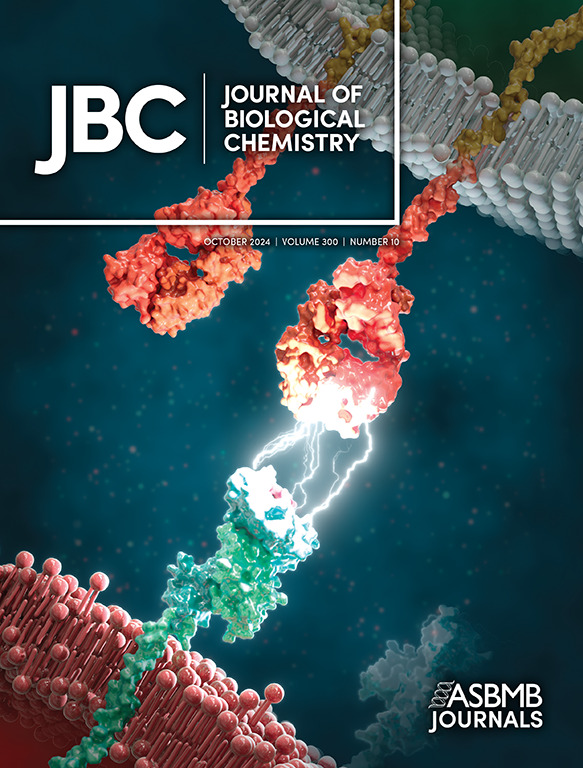丙酮酸:铁氧还蛋白氧化还原酶的氧化还原景观揭示了通常保守的Fe-S簇电位。
IF 4
2区 生物学
Q2 BIOCHEMISTRY & MOLECULAR BIOLOGY
引用次数: 0
摘要
本文研究了丙酮酸内部电子转移(ET)的热力学驱动力:铁氧还蛋白氧化还原酶(PFORs),通过比较来自黄绿杆菌(Ct)、海洋磁球菌(Mm)、活性甲烷菌(Ma)的一系列PFORs的氧化还原特性,并回顾了单一的历史先例——来自非洲脱硫弧菌的酶。这些酶需要一个硫胺素焦磷酸(TPP)辅因子、三个[4Fe-4S]簇和辅酶a (CoA)才能发挥活性,并且存在于利用反三羧酸(TCA循环)或其他还原途径进行二氧化碳还原和丙酮酸合成的厌氧生物中。然而,PFOR经常被认为是一种氧化酶,负责生成氧化还原载体铁氧还蛋白形式的还原等效物。以前理解PFOR机制的努力依赖于先前对铁硫氧化还原电位的报道,这些电位来自于不完全氧化还原滴定。在这里,我们使用直接蛋白膜电化学(PFE)提供了四种PFOR酶的并排比较,提供了铁硫簇氧化还原电位的新评估。由于Ma PFOR由多个多肽组成,我们对重组PorD亚基的研究使我们能够构建一个模型,其中修改的氧化还原电位被映射到特定的铁硫簇。本文章由计算机程序翻译,如有差异,请以英文原文为准。
The redox landscape of pyruvate:ferredoxin oxidoreductases reveals often conserved Fe-S cluster potentials.
Here we investigate the thermodynamic driving force of internal electron transfer (ET) of pyruvate:ferredoxin oxidoreductases (PFORs), by comparing the redox properties of a series of PFORs from Chlorobaculum tepidum (Ct), Magnetococcus marinus (Mm), Methanosarccina acetivorans (Ma), as well as revisiting the single historical precedent, the enzyme from Desulfovibrio africanus. These enzymes require a thiamine pyrophosphate (TPP) cofactor, three [4Fe-4S] clusters, and Coenzyme A (CoA) for activity and are found within anaerobic organisms that utilize the reverse tricarboxylic acid (TCA cycle), or other reductive pathways, performing CO2 reduction and pyruvate synthesis. Yet, PFOR is often invoked as an oxidative enzyme responsible for generating reducing equivalents in the form of the redox carrier ferredoxin. Previous efforts to understand the mechanism of PFOR have relied upon a prior report of the iron-sulfur redox potentials derived from an incomplete redox titration. Here we use direct protein film electrochemistry (PFE) to provide a side-by-comparison of four PFOR enzymes, providing a new assessment of the iron-sulfur cluster redox potentials. As the Ma PFOR is comprised of multiple polypeptides, our investigation of the recombinant PorD sub-unit allows us to construct a model where the revised redox-potentials are mapped to specific iron-sulfur clusters.
求助全文
通过发布文献求助,成功后即可免费获取论文全文。
去求助
来源期刊

Journal of Biological Chemistry
Biochemistry, Genetics and Molecular Biology-Biochemistry
自引率
4.20%
发文量
1233
期刊介绍:
The Journal of Biological Chemistry welcomes high-quality science that seeks to elucidate the molecular and cellular basis of biological processes. Papers published in JBC can therefore fall under the umbrellas of not only biological chemistry, chemical biology, or biochemistry, but also allied disciplines such as biophysics, systems biology, RNA biology, immunology, microbiology, neurobiology, epigenetics, computational biology, ’omics, and many more. The outcome of our focus on papers that contribute novel and important mechanistic insights, rather than on a particular topic area, is that JBC is truly a melting pot for scientists across disciplines. In addition, JBC welcomes papers that describe methods that will help scientists push their biochemical inquiries forward and resources that will be of use to the research community.
 求助内容:
求助内容: 应助结果提醒方式:
应助结果提醒方式:


